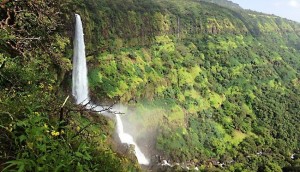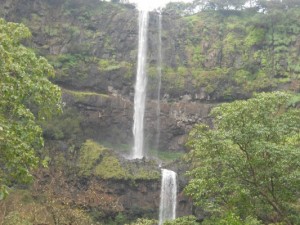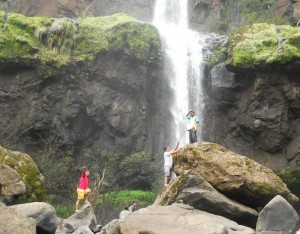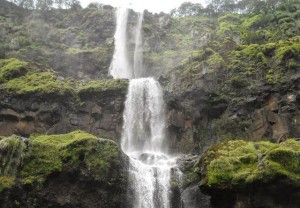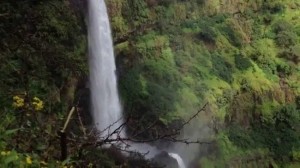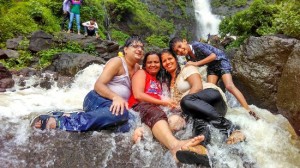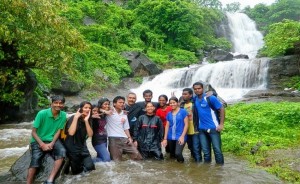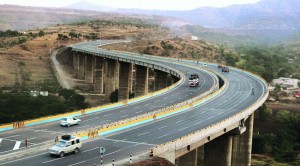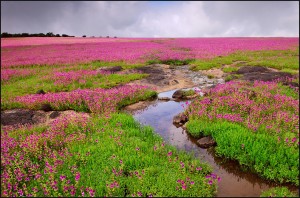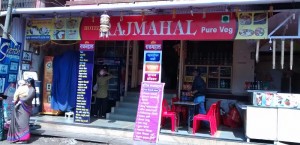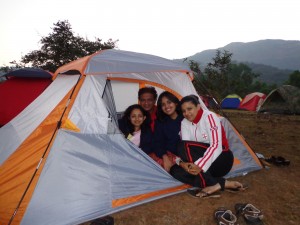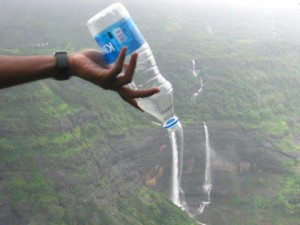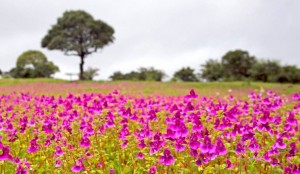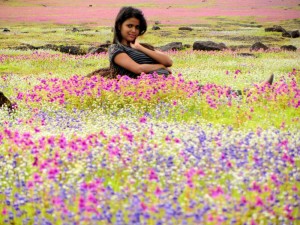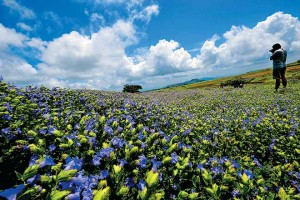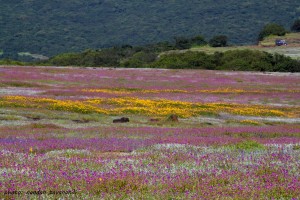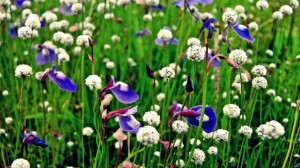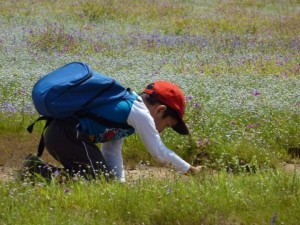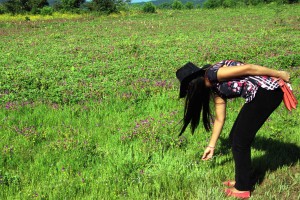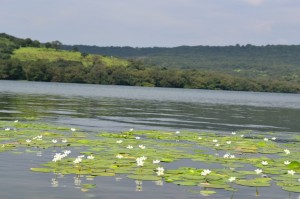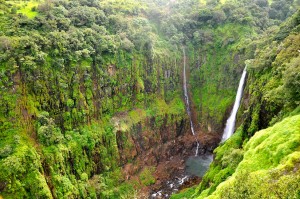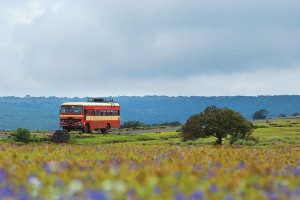The Vajrai Waterfalls is situated at a height of around 560 meters (1,840 feet), and is a pictorial waterfall located near the Sahyadri Mountains, close to Kass Plateau. The region is jam-packed with incredible natural beauty, along with a pleasant soothing climate throughout the year.
Normally, when one see this waterfall from a distance then it doesn’t seem to be a great waterfall, but when they reach near the waterfall and just have a look at it, only then they understand the enormity of it. The height of the waterfall being 1,840 feet falls from a straight cliff. The water for waterfall comes from the river Urmodi. It is origin of river Urmodi. The waterfall is perennial in nature, and hence you will hardly find it flowing throughout the year.
This waterfall is very famous and popular with tourists, and is one of tallest waterfalls in India. Its popularity has resulted in an immense fame for the Bhambavali village, and tourism has become a key business here for the local villagers.
This waterfall is a hub of beauty, nature and wild life along with some ancient holy places. Normally this waterfall enjoys great flow of water around the year, but during rainy seasons it gets stunning, with heavy water flow of water and the natural scenic beauty all around the waterfall.
To experience this true heaven on earth, one should certainly visit the falls at least once in lifetime. Bhambavali village is also famous due to religious factors associated with the Vajrai Waterfall. According to a local legend, the Marathi Saint Shri Samarth Ramdas Swami climbed this entire mountain in just 3 footsteps and due to this miracle the Vajrai Waterfall got converted into a ‘3 Stair Waterfall Mountain’. From that time onwards, the place is considered holy by the local tribe of the Bhambavali village.
The waterfall provides various other attractions like boating and trekking to the mesmerizing caves. There are also some ancient temples and religious places which are a major tourist attraction here.
Timing: Sunrise to Sunset.
Duration: 1 day outing. / Overnight.
Height of the waterfall: 1,840 Feet (560 Meters).
Best time to visit: July to September.
Entry Fee: N.A.
Open days: All days of the week.
Visit Duration: 2 – 3 hours.
Photography: Allowed.
For Bookings for Vajrai Waterfall PLEASE CLICK HERE
How to Reach
The Vajrai Waterfall is just 27 km from the city of Satara, Maharashtra, and is situated near the Sahyadri mountain ranges.
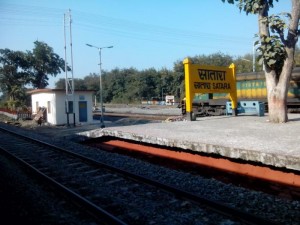
By Rail:
Satara Railway Station is just 30 km from Vajrai Waterfall and can be reached by local transport (taxi, bus and rickshaw).
By Road:
From Pune -> There are regular buses from Swargate bus stand to Satara. From Satara one can hire taxis or rickshaws and reach the falls.
There is regular bus service from Satara to Vajrai and Satara is well connected to Mumbai, Pune and other major cities by national highway.
Activities
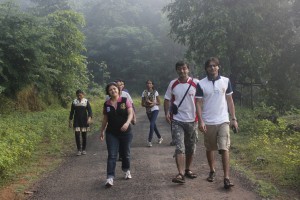
- Enjoy breathtaking views of the scenery and one of the tallest waterfalls in India.
- Take a hike to the ancient caves nearby.
- Enjoy boating in the Tapola region, near the falls.
- Enjoy picturesque views of the Urmodi Dam nearby.
- Enjoy a family picnic in the company of friends and family.
- Enjoy Photography.
- Enjoy Nature Walks.
For Bookings for Vajrai Waterfall PLEASE CLICK HERE
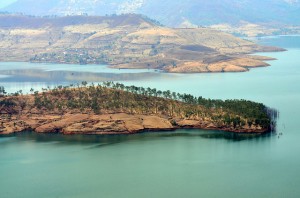
Precautions to be taken by Tourists
- Non-vegetarian food is prohibited nearby one km circle from waterfall as this place is considered sacred.
- Avoid visiting the place in heavy rains as the place can be dangerous.
- Carry a first aid kit.
- Swimming at waterfall is prohibited as deep ponds are formed at the base.
- Alcohol consumption is also prohibited.
- Avoid entering the dense forest without a local guide. Guides are available in the Bhambavali village at reasonable rate.
Places to see near the Waterfall
The Caves: There are many small ancient caves near Vajrai Waterfalls, which are a chief attraction for tourists beside the waterfall.
Urmodi Dam: The dam is situated on the Urmodi River; enjoy the views of Urmodi Dam and its back water area.
Kaas Flower Valley: Kaas is the small plateau, which comes alive with beautiful flowers between the months of August to October. There are many rare species of flowers, wild flowers, shrubs and plants to explore at Kass Plateau.
Bamnoli and Tapoli region: Here tourist can enjoy boating.
Sajjangadh Fort: This is the fort near Satara city, and the place where Shree Samarth Ramadas Swami lived. Hence the fort is named as Sajjangadh.
Thoseghar Waterfalls: This is a scenic spot located near the small village Thoseghar, this water fall is just 20 km from Satara city.
Mahabaleshwar Hill Station: Mahabaleshwar is the famous hill stations in Maharashtra. It is the famous as the holiday resort and honeymoon spot and has several tourist attractions.
Pachgani Hill Station: This is another hill station near the Waterfall, which surrounded by five hills of Sahyadri and has many tourist attractions.
Wai Ganapati: Dholya Ganapati temple at Wai is one of the most popular temple in Maharashtra. The idol of Ganapati is located on the ghat of Krishna River and it is very big.
Gondavale: It is very famous pilgrimage place and the Samadhi place of Shri Gondavalekar Maharaj.
Explore the dense Forest of Bhambavli, ideal for nature lovers and trekkers.
For Bookings for Vajrai Waterfall PLEASE CLICK HERE
Where to Eat and Stay
Since the waterfalls are located in the wilderness there are no accommodations facilities in this area. Tourist planning an overnight stay will have to stay at hotels or guest houses in Satara.
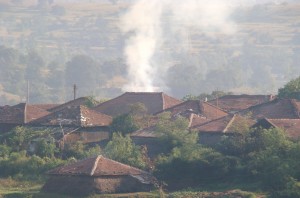
The more adventurous can experience a stay Bhambavali village in traditional homes, this stay will give you a chance to live and experience a rural life.
It is further advisable to carry your own snacks and water as there is one restaurant near the waterfalls, which serves Maharastrian food. For a wholesome meal, tourists are advised to enjoy the same at Satara.
For Bookings a stay in Satara PLEASE CLICK HERE
Camping
There is no official arrangement or infrastructure for camping at the water falls near Vajrai Waterfall.
But adventure enthusiast seeking adventure can try their luck and seek permission from the local authorities and enjoy a camp near the falls.
For Bookings for Camping at Vajrai Waterfall PLEASE CLICK HERE
A Humble Request
While visiting Vajrai Waterfalls, please do not litter and help keep the nature and surroundings clean by carrying back your thrash and disposing it in a decent manner.
Also do not pollute the water as it is an important source of water for the people living in the nearby villages. Kindly support nature as these small actions by each one of us will help preserve our beautiful waterfalls.

